Civil service staff numbers
Who exactly are civil servants and how many are there?
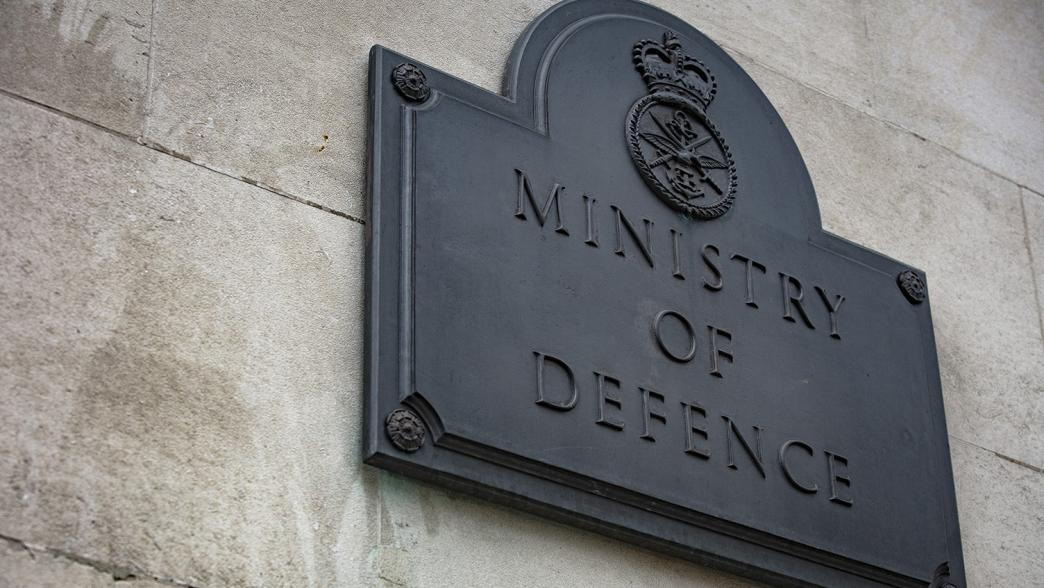
Who exactly are civil servants?
We define civil servants as politically impartial, appointed officials of the UK Home Civil Service, which supports the work of the UK’s central government departments. This includes agencies that employ civil servants such as executive agencies, non-ministerial departments and some non-departmental public bodies.
Our definition includes the staff of the Scottish and Welsh devolved governments, but not the staff of the Northern Ireland Civil Service , which is administratively distinct. We also include officials working in the three Whitehall-based territorial offices that manage the UK’s relationship with Scotland, Wales and Northern Ireland.
In this way, civil servants are defined much more narrowly than public sector workers: police, teachers, NHS staff, members of the armed forces and local government officers are not counted as civil servants.
The data we use for our analysis of civil service staff numbers comes from the Office for National Statistics (ONS), which provides quarterly estimates of the number of civil servants employed, both in terms of absolute headcount and full-time equivalent.
We organise each body into ‘departmental groups’ according to which secretary of state has ultimate ministerial responsibility for the organisation in question. We do this even in cases where a body’s staff numbers are reported separately to their central Whitehall department. For instance, we group Ofsted with the Department for Education (DfE) departmental group and not as a separate department.
To define which bodies belong to which departmental groups, we have used both the ONS’ quarterly public sector employment reports and the most recent (2020) Public Bodies report published by the Cabinet Office. For a full breakdown of each departmental group, see the methodology from our latest Whitehall Monitor report.
Unless otherwise indicated, the figures given throughout this explainer are for departmental groups, and therefore include the civil servants who work in ‘core’ departments as well as the agencies and non-ministerial departments they oversee.
It was only in Q3 2023 that the ONS figures began to reflect the machinery of government changes announced in February 2023, which included the creation of several new departments. As a result, some charts depicting change over time exclude these new departments and / or their predecessors.
When comparing the size of departments over time, we exclude the effect of smaller machinery of government changes, where staff have been transferred between departments.
How many civil servants are there?
As of December 2023, there were 502,710 full-time equivalent (FTE) civil servants – 6,595 (1.3%) more than in the previous quarter, which is the second highest quarterly growth rate since Q3 2021. There are now 19,260 (4%) more civil servants than a year ago.
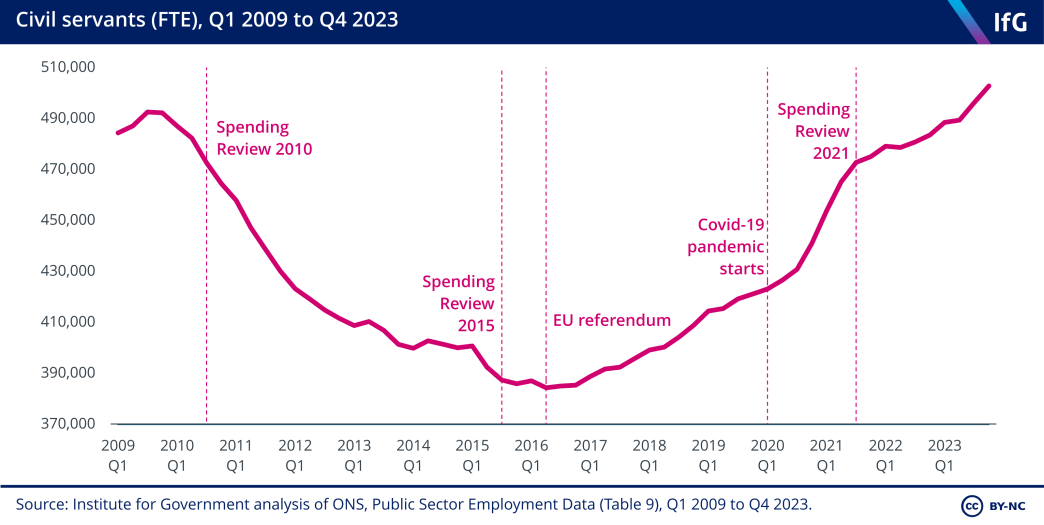
The total number of civil servants has fluctuated significantly since 2010. The size of the civil service, already falling before the 2010 Spending Review, fell by 19% between 2010 and 2016. This meant that in June 2016, when the EU referendum took place, the civil service had a workforce of 384,230 – the smallest it had been since the Second World War, although numbers never quite reached the low of 380,000 anticipated by the 2012 Civil Service Reform Plan. 16 Civil Service, ‘Civil Service reform plan’, June 2012, retrieved 16 March 2023, www.gov.uk/government/publications/civil-service-reform-plan, p. 11
After the referendum, civil service numbers grew in every quarter, with the rate of growth accelerating during the pandemic, surpassing the 2010 headcount at the beginning of 2022. Following a slight fall in Q2 2022 (when numbers fell by 540 staff compared to Q1), numbers have continued to rise in the most recent quarters.
Because this growth of the civil service since 2016 was partly spurred by the preparations to leave the EU and the pandemic, there has been a notable increase in the number of policy specialists. Since March 2016, just before the EU referendum, the policy profession has grown by 15,565 staff – an increase of 94%. However, both the digital, data and technology profession and the analytics profession have also grown significantly – by 107% and 108% respectively, though the absolute increases in numbers are smaller than in the policy profession. The largest absolute increase in the number of civil servants since 2016 has been in the operational delivery profession, which has grown by almost 37,000 (17%).
After this significant growth in the size of the civil service, recent governments have committed to cut it. In October 2021, as part of the 2021–24 spending review, the government set an aim to “reduce non-frontline civil service headcount to 2019-20 levels by 2024-25”. 17 HM Treasury, ‘Autumn budget and spending review 2021 documents’, October 2021, retrieved 17 March 2022, www.gov.uk/government/publications/autumn-budget-and-spending-review-2021-documents, p. 45. It is estimated that around half the civil service workforce undertake delivery roles directly with the public 18 Guerin B, Thomas A, Clyne R and Vira S, Finding the Right Skills for the Civil Service, Institute for Government, 2021, retrieved 17 March 2022, www.instituteforgovernment.org.uk/publications/civil-service-skills – meaning that the government would have had to cut an estimated 28,500 to 57,000 roles, depending on how it defined “frontline” officials.
In May 2022, the government revised its target upwards, to removing 91,000 civil service roles over three years, based on a return to 2016 staffing levels. 19 BBC News, ‘Boris Johnson wants to cut up to 91,000 civil service jobs’, 13 May 2022, retrieved 23 May 2022, www.bbc.co.uk/news/uk-politics-61432498 The Sunak government later abandoned this specific headcount target in November 2022 while maintaining that staff reductions and efficiency savings were needed. 20 BBC News, ‘Rishi Sunak No 91,000 target for civil service job cuts’, 1 November 2022, retrieved 13 December 2022, www.bbc.co.uk/news/uk-politics-63477209 It later, in October 2023, announced an immediate cap on the size of the civil service, and a future ambition to reduce it to pre-pandemic levels. However, it appears that this headcount cap has not yet been effective.
Indeed the latest figures show a significant increase in headcount between September 2023 and December 2023, of 6,600 FTE (1.33%). This growth has made the government’s aim harder – reducing the size of the civil service to pre-pandemic levels (Q1 2020) would now mean cutting around 80,000 roles. It is not yet clear how these reductions will be made.
How many civil servants are employed by each department?
There is great variation in the number of civil servants employed in different government departments.
The largest departments are often those whose work is focussed on ‘delivery’, or providing services directly to the public. The Ministry of Justice (MoJ), for example, employs tens of thousands of prison officers, and is the largest department with almost 90,000 staff in total. The Department for Work and Pensions (DWP) administers universal credit, tax credits and pensions, and is the second largest department with almost 81,600 staff. The third largest is HMRC, with over 65,000 staff. Approximately 69% of all civil servants work in the five largest departments, or their respective agencies and non-departmental bodies: the MoJ, DWP, HMRC, the Ministry of Defence (MoD) and the Home Office (HO).
The five smallest departments in terms of staff are the Department for Culture, Media and Sport (DCMS), HM Treasury, the Department for Science, Innovation and Technology (DSIT), the Department for Energy Security and Net Zero (DESNZ) and the Foreign, Commonwealth and Development Office (FCDO). These departments can be less than a twentieth of the size of the largest departments. DCMS, for example, has 2,775 staff. The Treasury has 3,175 staff, while DSIT has 5,500.
Departments also differ in how their staff are organised. In the larger departments, except for MoJ, most civil servants often work in the ‘core’ departments, rather than in executive agencies or non-ministerial departments that the core department oversees. By contrast, departments such as the Department for Transport (DfT), the Department of Health and Social Care (DHSC) and the Department for Levelling Up, Housing and Communities (DLUHC) have more of their staff in the bodies that they oversee than in the core department: there are 3,460 staff in DLUHC’s core department and 7,205 in the organisations it oversees, such as HM Land Registry. In the case of the MoJ, the vast majority of staff in the departmental group are employed by HM Prison and Probation Service.
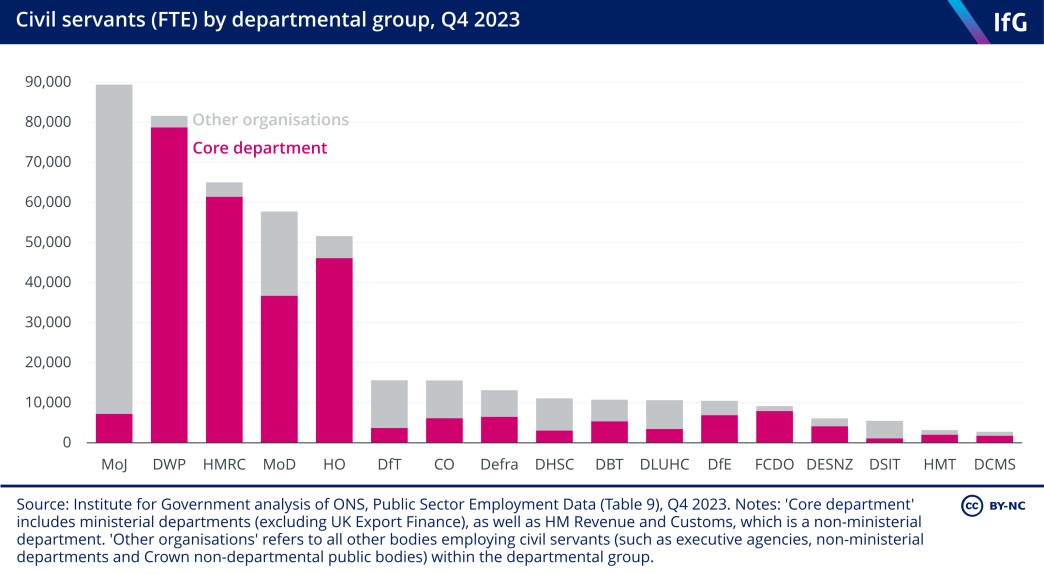
How have civil service numbers changed in different departments?
The fluctuation in the overall size of the civil service since 2010 is reflected in individual departments’ staffing numbers. Most departments saw their numbers of civil servants fall after the 2010 Spending Review, before rising in later years.
All but four departments now have more civil servants than they did in 2010. DCMS has almost quadrupled in size, while DfE has more than doubled. But key ‘operational’ departments which employ large numbers of staff – DWP, MoJ and HMRC – employ fewer civil servants now than they did in 2010.
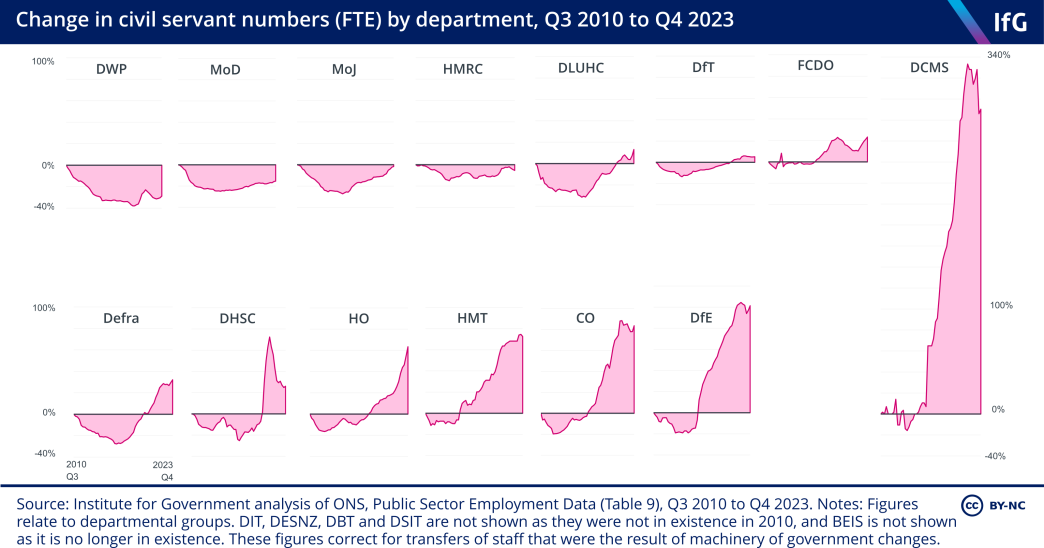
The specific drivers of recent expansions in the civil service – Brexit preparations and the pandemic – are to some extent evident in the departmental trends.
Before its merger with BEIS to form the Department for Business and Trade, DIT more than tripled in size since its staff numbers were first reported in Q4 2016, following its creation in the wake of the referendum result. Other departments which had significant responsibilities preparing for and implementing Brexit, such as DCMS, the Cabinet Office and Defra, also saw significant proportional growth after the referendum.
The pandemic also drove growth in the number of civil servants. As evident in the pink chart above, between Q4 2019 and Q3 2021, DHSC saw the highest proportional growth of all departments – adding 4,220 civil servants (46%). The department has since seen a trend of reducing its numbers of civil servants, perhaps due to pandemic pressures abating.
However, as noted above, the most significant driver of the growth of the civil service since 2016 has been the operational delivery profession. This has taken place in the more frontline departments, such as MoJ and the Home Office, some of which saw significant cuts between 2010 and 2016.
What are the latest changes to civil service staff numbers?
Data from the latest quarter (Q4 2023) show reductions in staff at HMT and HMRC.
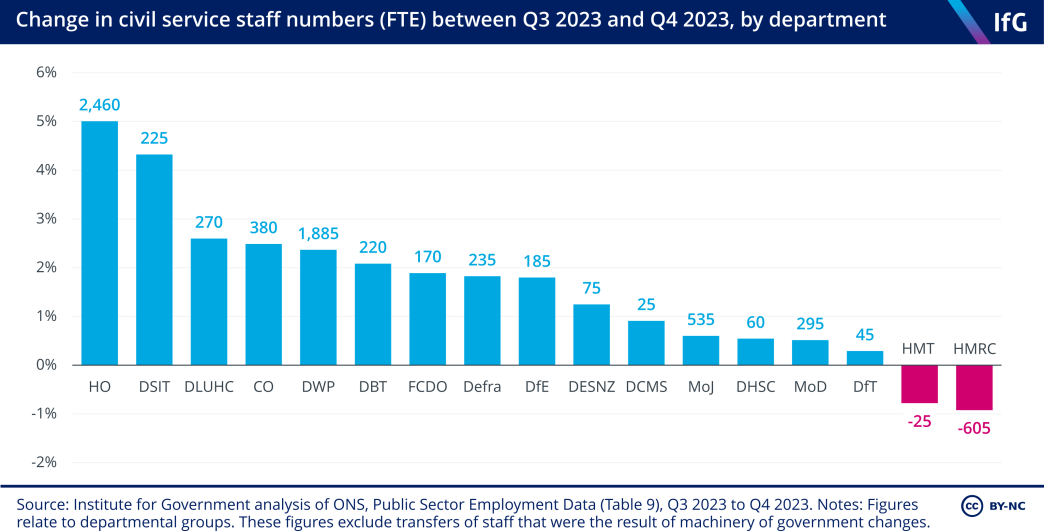
The largest proportional increases this quarter were seen at the Home Office, DLUHC and DSIT. The Home Office has grown every quarter from Q1 2017, and has increased significantly in size since 2021, likely due to more hiring of asylum caseworkers. The growth of DSIT, meanwhile, is unsurprising following its recent creation.
Over the past year, the Home Office has seen the highest proportional growth, while the FCDO has seen its first run of growth since 2019.
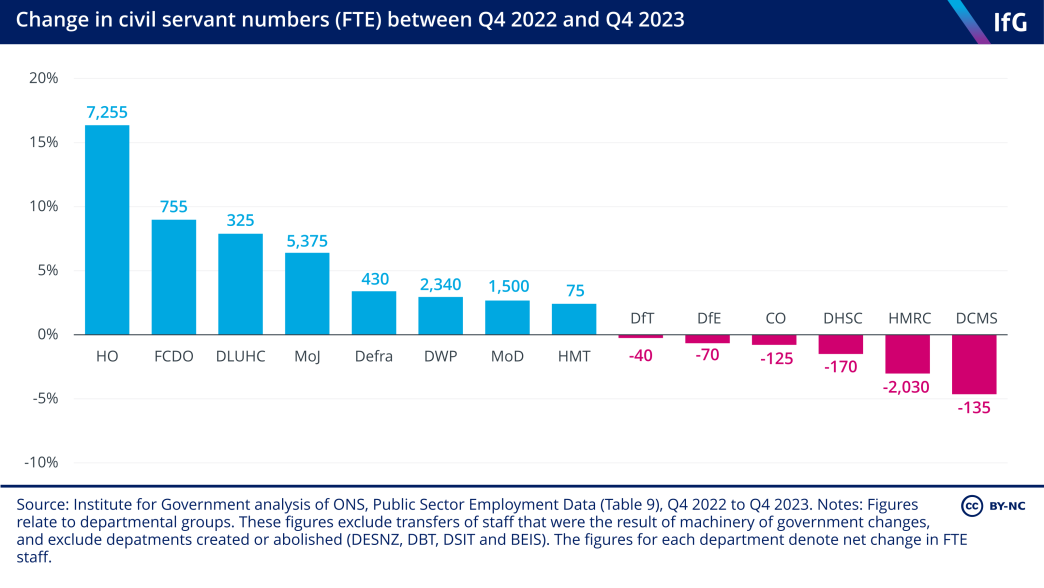
- Topic
- Civil service
- Department
- Cabinet Office
- Publisher
- Institute for Government